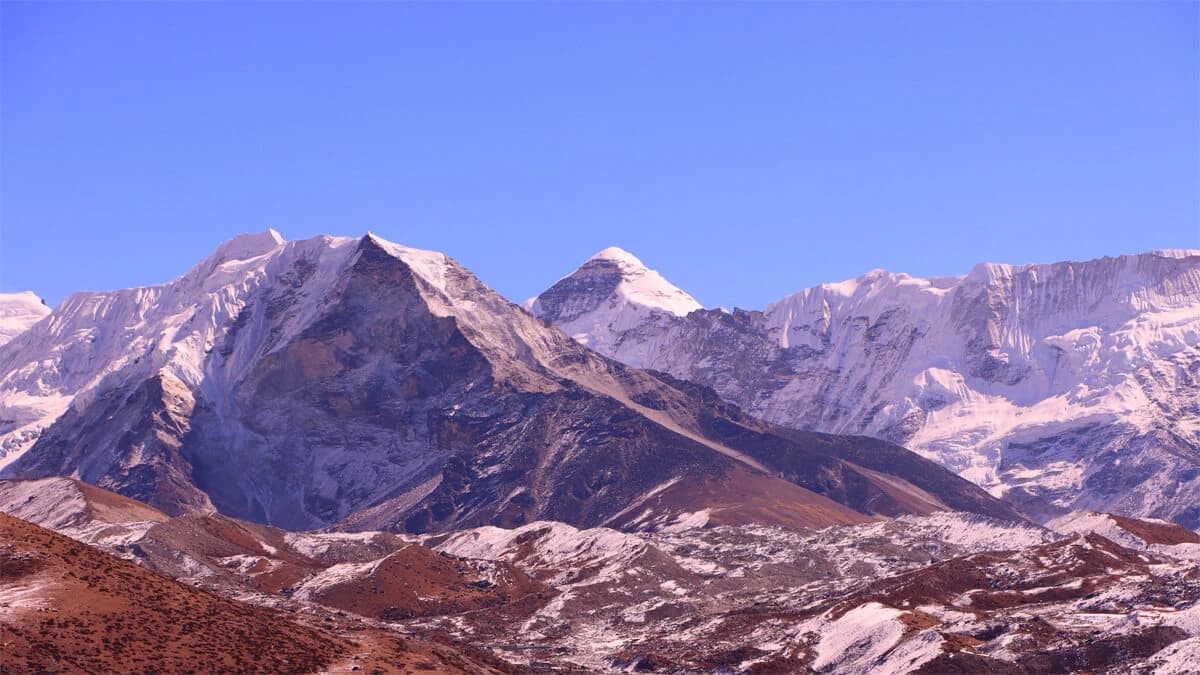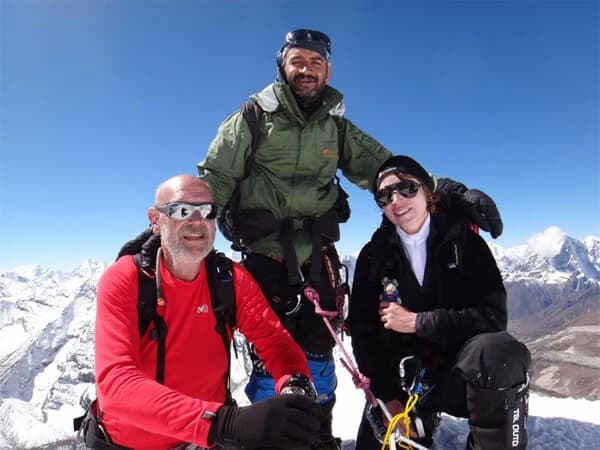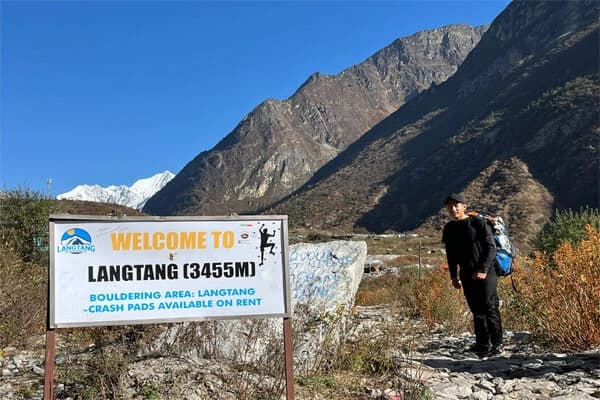Peak climbing in Nepal is fun as well as a challenging activity. There are around 1310 peaks in Nepal. Out of 1310, 27 are graded as the expedition peak in Nepal by Nepal Mountaineering Association (NMA). These trekking peaks are comparatively easier to climb than high mountains like Everest, Makalu, Langtang, and Annapurna. Hiking peaks can be a training for mountaineers who want to climb the summit of the highest mountains.
Climbing trekking peaks gives you a thrill and adventure at the same time. Although, the journey is not easy and requires extensive preparation. Trekking in the Nepalese mountain region is also a great way to learn about the unique culture and lifestyle of the people of that region. Mountain climbing is a strenuous task that grows us personally and professionally.
If you are planning to climb the summit of Nepalese peaks, you will find detailed information in this blog post. We will share the seven best trekking peaks and what challenges you may face while conquering these peaks.
Best peak climbing in Nepal
Mera Peak climbing highlights
- The highest trekking peak in Nepal: Mera Peak, at 6,476 meters (21,247 ft.), is the highest trekking peak in Nepal. This makes it a great goal for trekkers looking to challenge themselves while also enjoying the beauty of the Himalaya.
- Incredible views: The views from Mera Peak are some of the best in the Himalaya. On a clear day, you can see the five highest peaks in Nepal—Everest, Lhotse, Makalu, Cho Oyu, and Kanchenjunga—as well as a host of other stunning mountain ranges.
- Glacial lakes and meadows: The trek to Mera Peak takes you through a variety of landscapes, from lush green forests to high-altitude glacial lakes. You can also take time to enjoy the wildflower-filled meadows and take in the stunning views of the Himalaya.
- High-altitude trekking: Mera Peak is a great challenge for trekkers looking to test their limits. The peak stands at 6,476 meters (21,247 ft.), making it one of the highest trekking peaks in the world.
Mera Peak Climbing is one of the famous hiking peaks in Nepal. Climbing Mera peak is the best choice for novice and seasoned peak climbers.
Mera peak lies in the southern part of Mt. Everest- the world's highest massif. And the southwest of another expedition peak, Island Peak Climbing (6189 meters) in the Mahalangur region. Mount Mera has three summits over 6000 meters (North, Central, and South). Moreover, Mera Central (6461 meters) is the first preference of any trekker who wants to summit Mera.
Travelers can witness beautiful glimpses of Mount Everest, Mount Makalu, Mt. Cho Oyu, and Mt. Kanchenjunga from the top of Mera Peak. Mera Peak and Everest Base Camp Trek follow the same trails from Lukla.
It passes through Sherpa villages, suspension bridges, traditional Gompas, and lush forests. The beauty of mountains and trekking in Nepal is inexplicable in a few thousand words since they teach us more than our school and university do. It's hard to reach the summit of the mountains like Mera. But we can do it with good training and preparation. Regular trekkers with good physical shape can hike Mera Peak. We also provide an experienced porter guide to help you in your journey through Mera and other peaks in Nepal.
Island Peak Climbing Highlights
- Enjoy stunning views of the Himalayan peaks from the summit of Island Peak
- Trek to Everest Base Camp and explore the world’s highest mountain range
- Enjoy the local culture and hospitality of the Sherpa people
- Explore the beautiful Khumbu Valley and its many monasteries
- Climb Island Peak, a challenging but rewarding peak at 6,189m
- Learn the basics of mountain climbing, including how to use an ice axe and crampons
- Visit the local village of Chhukung and enjoy the hot springs there
The Island peak is the second most loved hiking peak in Nepal after Mera peak. Island peak climbing is one of the most loved excursions for all grades of mountaineers on the planet. The south summit of Imja Tse, or Island Peak, was a training peak for Tenzing Norgay Sherpa in 1953. After three years, Hans-Rudolf Von Gunten and two Sherpas chased its main summit. The same year that team climbed Mount Everest and Mount Lhotse.
Many travelers combine Imja Tse peak climbing with the classic Everest Base Camp Trek to gain the ultimate experience of hiking and climbing on the same trip. Climbing Island peak is suitable for both newcomers and serial mountaineers.
It's not so technical until you get stuck on the 100-meter steep, high ascent before reaching its top. Nepal Trekking Routes 19-day Island Peak Climbing is the best opportunity to explore mountains and heal body and mind amidst nature. Island's last village point, Imja Valley, is covered by glacial lakes and gorges.
Lobuche peak climbing Highlights
- Enjoy the spectacular views of the Himalayan peaks from Kalapatthar
- Trek through the Sherpa villages
- Explore the culture and traditions of the local Sherpa people
- Pass through the beautiful glaciers and moraines
- Reach the summit of Lobuche (6,119m)
- Experience the thrill of climbing a peak in the mighty Himalayas
Lobuche is another trekking peak in the Everest region. This trip is a good feat for extremely adventurous and daring climbers. In the Everest region, you may experience a once-in-a-lifetime moment while ascending the peak of Lobuche. Lobuche has two summits, east (6119) and west (6145) meters.
While ascending the Lobuche, you may feel more technical than its neighbors Island and Mera peak of the same Mahalangur section.
You can reach the top of both faces of Lobuche in the same hike. The challenging Lobuche peak climbing trip rewards with appealing scenery of several highest mountains. Hiking to Lobuche summit follows the same trails as Everest Base Camp Trek, Everest High Passes trek, and Gokyo Ri Trek.
Yala peak climbing highlights.
- Trek through the Langtang National Park.
- Climb to the summit of Yala Peak (5320 meters)
- Enjoy the spectacular views of Mt. Langtang Lirung, Mt. Ganesh Himal, and other peaks.
- Experience the unique culture and traditions of the Tamang and Sherpa people.
- Explore the beautiful landscapes of Langtang Valley
Yala Peak climbing is a famous hiking peak in the Langtang region. It is one of the shortest peaks from the capital city, Kathmandu. The trek to Yala Peak connects one of the most loved travel destinations, Langtang Trek.
Usually, mountaineers combine Yala Peak along Langtang Valley Trek. Langtang Valley is also famous for its Tibetan-influenced cultural village in closeness to Mount Langtang and Yala Peak. The trail also passes through Langtang national park. Trekkers walk through rhododendron forests where snow leopards and red pandas occur occasionally.
Langtang national park is the first high-altitude protection area in Nepal. Many travelers prefer this place because of its closeness to Kathmandu.
Hiking to Yala Peak shows the Tamang Heritage trail- another popular trekking route in this area. Sherpa and Tamang are the inhabitants of the Langtang region. Travelers can also enjoy the organic cheese of Kyanjin Cheese Factory and the tranquility of Kyanjin and Sing Gompa during their visit. This trip is suitable for beginner mountaineers and strenuous trekkers. Nepal Trekking Routes’ 17-day itinerary is fit for anyone who wants to climb the Yala Peak summit.
Tent peak climbing Highlights
- Tent Peak Climbing is an amazing adventure that offers spectacular views of the Himalayas and the surrounding landscape.
- The climb to Tent Peak is one of the most challenging climbs in the Annapurna region, but it is well worth the effort as the views from the summit are simply breathtaking.
- The peak is located at an altitude of 6,023 meters and offers stunning views of Annapurna I, Annapurna South, Hiunchuli, Fishtail, and other peaks in the Annapurna range.
- The climb takes around six days and involves camping at high altitudes, so it is important to be well-prepared for the trek.
- The trek is suitable for experienced mountaineers and trekkers, as it involves steep ascents and descents, so it is important to be well-prepared and physically fit.
- The trek can be done in both spring and autumn, and the best months to climb Tent Peak are March to May and September to November.
- Climbing Tent Peak is an amazing experience that offers a unique view of the Himalayas, and a great way to experience the beauty of the Annapurna region.
Tent peak climbing is one of the enjoyable journeys to the summit of a hiking peak above 5500 meters. Tharpu Chuli is one of the primary peaks in the Annapurna region. It is near the lake city of Pokhara, Nepal.
Travelers can combine Tent peak climbing with Annapurna Base Camp Trek or Machhapuchhre Base Camp Trek. However, you can also do a Tent climb trek alone.
While walking in the Annapurna region, you may witness Himalayan black bears, musk deer, monkeys, langurs, and other rare animals. The trail to Tent peak moves forward from Annapurna Base camp. During this trip, you should be careful while crossing crevasses when ascending to the top.
En route to Tharpu Chuli, you get the best hospitality from local ethnic Gurung people in their homestays. They show cultural programs to welcome guests to their region. An expert guide and porter can make your Tent Peak expedition fun and memorable.
Pisang peak climbing Highlights
- Magnificent views of the Annapurna range, Manaslu range, Ganesh Himal range and many other snow-capped peaks.
- Spectacular views of the Machhapuchhre (Fish Tail Peak).
- Possibility of exploring the rich flora and fauna of the region.
- Opportunity to explore the ancient Thakali culture and tradition.
- Interaction with the local people and an opportunity to learn about their lifestyle.
- Unique experience of trekking through the picturesque landscape of the Himalayas.
- Experiencing the thrill of climbing a technically challenging peak.
- A chance to summit one of the most beautiful and popular peaks in the Annapurna region
Pisang Peak climbing is another choice for hiking trekking peaks in Nepal. It lies in the gorgeous Manag Valley. Many trekkers around the globe have chased its summit because it is not technical. You can also attempt this trip combined with the Annapurna round trek. Combining Pisang with the Annapurna round trek is a great choice to see Pisang Peak, Thorung La Pass, and Muktinath temple on the same trip.
Even though it does not require technical skills, you must be careful when crossing glaciers and crevasses. And reaching the summit is a bit challenging. But it is worth it when the Annapurna range rewards you with magical views.
Altitude may create trouble for you while hiking in the Himalayas. To avoid any risk associated with it, plan extra acclimatization days. And you also require proper climbing equipment while climbing mountains.
Chulu East peak climbing Highlights
- Spectacular views of mountains, glaciers, and moraines.
- Experience the beauty of the Annapurna Massif.
- Visit the picturesque Pokhara Valley and the quaint villages of the Gurung people.
- Trek through rhododendron, bamboo, and alpine forests.
- Visit the famous Muktinath Temple, one of the holiest Hindu sites in Nepal.
- Spend a night in the Chulu Base Camp, situated at the foot of Chulu East.
- Ascend to the summit of Chulu East (6,419m/21,047ft) and enjoy the incredible views.
Chulu East peak climbing is one of the top expedition peaks in Nepal. Cholu East also has a west face, Cholu west (6059 m).
Cholu joins the Annapurna massif range and Damodar Mountain. Some trekkers prefer hiking alone on the Cholu East route, while others try to integrate with Thorung La pass Trek. It is a good combination of a high-pass hike and peak climbing in Nepal. Only serious climbers with proper knowledge and experience in peak climbing in Nepal can opt for the trip.
The way to Cholu East covers Kali Gandaki and Marshyangdi river valley. You require appropriate gear and equipment to climb the Cholu Mountains.
What are the challenges to climbing Peak in Nepal?
Physical challenges
While climbing peaks in Nepal, physical fitness plays a vital role. Climbing the Nepal expedition peak is physically challenging, requiring high strength and endurance. It will need good preparation and physical fitness. Several peaks in Nepal are suitable for novices to seasoned mountaineers. If you want to begin your mountain climbing journey, Mera and Island peaks are good options. And if you are a serial mountaineer, then opt for 8000-meter peaks.
Cardio, peak climbing training, and long hiking are the best to enhance physical strength and endurance. Travelers must be familiar with climbing gears and equipment before heading towards the mountain.
Mountaineering is for a serious traveler who wants to spend money, time, and energy while climbing the summit. For those travelers who can not afford that much, they can hike to the charter point of these peaks with minimal preparation.
Altitude Sickness
Another challenge of climbing peaks in Nepal and Trekking in Nepal is altitude sickness. Nepal is a homeland of many climbing peaks that lie at high altitudes. And walking to these highest peaks can lead to altitude sickness.
AMS can catch you anytime in the mountains, even if you are not a first-timer. Be aware of AMS symptoms and its coping mechanism before hiking the highest peaks. Nausea, Vomiting, Fatigue, and swelling of hands and other body parts are a few examples of HIMS. To prevent altitude sickness, keep hydrated all day, go straight on the trail, and follow the guide and porter's advice. Likewise, take proper climate acclimatization before heading towards the summit. Avoid mountain dreams if you are suffering from a long-term health problem.
Extreme Weather
Nepalese Himalayan ranges' weather is unpredictable. It may experience extreme weather conditions like storms, high winds, and snow storms. So, it's better to prepare for the worst kinds of climate experience as you ascend towards the summit of these peaks. The mountaineering team must bring the right gear, reliable shelter, and appropriate clothing to combat these kinds of hazards in the expedition.
Selecting the best season
Every Nepali climbing peak requires decent weather for the expedition. Spring and Fall seasons are favorable for attempting mountaineering in Nepal. Meanwhile, winter and summer are so dangerous due to climate and weather conditions. Our expedition history also shows that Many successful summits happen in the Autumn and spring seasons.
Another reason for choosing these seasons is that there is less probability of rain, clear visibility in the skies, and less chance of winds and snow storms. This season is also suitable for a whole Nepal Tour and Trekking destinations.
Safety
Going into the high mountains for the first time can be trouble even if you follow all the rules. When you reach an altitude of over 5000 meters, it is difficult to hike uphill. To prevent ill from the AMS and to allow your body to acclimate, you should follow an acclimation plan. Add some extra days to your resting plan that helps you in case of weather changes and other unfavorable events. While focusing on safety to climbing mountains, always add travel insurance and a rescue evacuation plan in your showdown.
Hiring an expert guide and porter
Climbing peaks in Nepal is only possible with the help of an experienced and professional guide and porter. Always choose a trustworthy travel firm and hire an NMA advanced certified guide. A helpful guide always supports you in case you catch any trouble. Travelers prefer Sherpa guides for mountaineering because they are local with long experience in climbing high peaks in the Nepalese Himalayas.
You can minimize the risk by booking trips with Nepal Trekking Routes. We provide English-fluent and certified guides. They are keen to share their climbing skills with you. They are familiar with first aid instructions, crisis handling, and climbing training. Every member of our crew brings proper and well-trained equipment and machinery. Similarly, porters also help in your journey.
Limited resources for Food and Accommodation
Many Nepalese climbing trails are isolated, and they have less access to proper food, water, and medical care. After crossing high villages, travelers need to stay in tents. However, managing your food and accommodation is the responsibility of the trekking company. You only focus on your journey.
Conclusion: Best Peak Climbing in Nepal
Nepalese climbing peaks provide a beautiful experience with astounding landscapes, unique villages, the highest massifs, and fierce river falls. Despite all challenges, climbing mountain peaks in Nepal is a rewarding experience. Any serious mountaineer can attempt these peaks with good preparation and training. If you overcome such challenges, your journey will be memorable.







